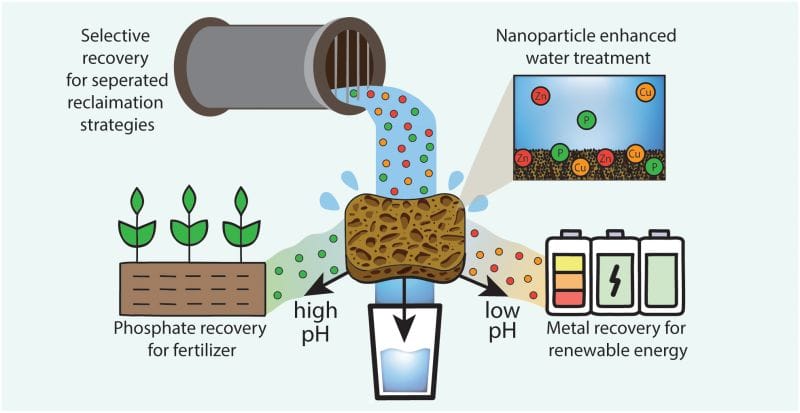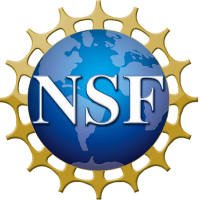RSS feed source: National Science Foundation
Funded by multiple grants from the U.S. National Science Foundation, researchers created a functional sponge that can soak up certain pollutants from water and then release them on demand, presenting a reusable and low-cost solution for cleaning storm runoff while simultaneously recovering valuable metals like zinc and copper, as well as phosphate.
Using surface iron oxide nanoparticles specialized for capturing specific contaminants, the sponge collects the minerals and then discharges them only when triggered by changes in pH, and it can be used multiple times. The findings were achieved by researchers at Northwestern University and published in the American Chemical Society’s journal Environmental Science and Technology Water.
“The technology can be used as a universal sorbent or ‘catch-all,’ or it can be tailored to certain groups of contaminants like metals, plastics or nutrients,” says Vinayak Dravid, a research author and Northwestern professor of materials science and engineering. In previous iterations, the sponge material has successfully pulled lead, microplastics and oil from water.
Industrial manufacturing and agriculture, in particular, experience mineral and fertilizer loss due to runoff, leaving valuable nonrenewable resources as pollutants in bodies of water. Those resources include heavy metals like zinc and copper and also phosphate.
RSS feed source: National Science Foundation
In-brief analysis
May 5, 2025
Data source: AAA
Retail prices for regular grade gasoline in California are consistently higher than in any other state in the continental United States, often exceeding the national average by more than a dollar per gallon. Several factors contribute to this high price, including state taxes and fees, environmental requirements, special fuel requirements, and isolated petroleum markets.
Taxes and fees
The components of retail gasoline prices are taxes and fees, distribution and marketing, refining costs, and crude oil prices. Drivers in California pay the highest taxes at the pump, equivalent to $0.90 per gallon (gal) between local, state, and federal taxes as of March 2025.
Federal taxes—which are the same for each state—account for $0.18 of the $0.90/gal in taxes. The other $0.72/gal is made up of state excise tax
Click this link to continue reading the article on the source website.
RSS feed source: National Science Foundation
U.S. National Science Foundation-supported research shows that fires in populated areas are three times more likely to lead to premature deaths than wildfires overall, informing fire mitigation efforts.
Scientists at the NSF National Center for Atmospheric Research (NSF NCAR) led the study, published in Science Advances, which found that smoke from fires that blaze through the wildland-urban interface (WUI) has far greater health impacts than smoke from wildfires in remote areas.
“This research will support the development of advanced fire prevention strategies, improve building codes and lead to effective emergency response plans,” said Bernard Grant, a program director in the NSF Directorate for Geosciences. “It will help protect lives and homes, safeguard natural ecosystems and reduce the economic burden of wildfire disasters,”
The researchers used an advanced NSF NCAR-based computer model, the Multi-Scale Infrastructure for Chemistry and Aerosols, to simulate pollutants from fires. Their modeling included carbon monoxide chemical tracers, which allowed them to estimate emission sources and differentiate between wildland and WUI fires.
“The health impacts are proportionately large because they’re close to human populations,” said NSF NCAR scientist Wenfu Tang, the report’s lead author. “Pollutants emitted by WUI fires, such as particulate matter and the precursors to ozone, are more harmful because they’re not dispersing across hundreds or thousands of miles.”
Click this link to continue reading the article on the source website.
RSS feed source: National Science Foundation
Synopsis
The Science and Technology Centers (STC): Integrative Partnerships program supports exceptionally innovative, complex research and education projects that require large-scale, long-term awards. STCs focus on creating new scientific paradigms, establishing entirely new scientific disciplines, and developing transformative technologies which have the potential for broad scientific or societal impact. STCs conduct world-class research through partnerships among institutions of higher education, national laboratories, industrial organizations, other public or private entities, and via international collaborations, as appropriate. They provide a means to undertake potentially groundbreaking investigations at the interfaces of disciplines and/or highly innovative approaches within disciplines. STCs may involve any area of science and engineering that NSF supports. STC investments support the NSF vision of creating and exploiting new concepts in science and engineering and providing global leadership in research and education.
Centers provide a rich environment for encouraging scientists, engineers, and educators to take risks
Click this link to continue reading the article on the source website.



